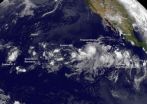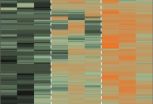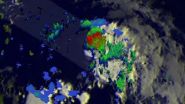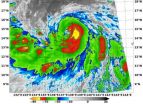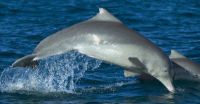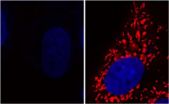(Press-News.org) Coral Gables, Fla. (July 31, 2014) -- Quantifying and transforming the history of culture into visual representation isn't easy. There are thousands of individual stories, across thousands of years, to consider, and some historical conditions are nearly impossible to measure.
Addressing this challenge, Dr. Maximilian Schich, associate professor of arts and technology at The University of Texas at Dallas, brought together a team of network and complexity scientists, including University of Miami physicist Chaoming Song, to create and quantify a big picture of European and North American cultural history.
Schich and his fellow researchers reconstructed the migration and mobility patterns of more than 150,000 notable individuals over a time span of two thousand years. By connecting the birth and death locations of each individual, and drawing and animating lines between the two locations, Schich and his team have made progress in our understanding of large-scale cultural dynamics.
The research is detailed in the article "Historical Patterns in Cultural History," published Aug. 1 in the journal Science.
Song, an assistant professor in the Department of Physics at the University of Miami College of Arts and Sciences, is a co-author of the study. A statistical physicist, Song's research lies in the intersection of statistical physics, network science, biological science and computational social science, broadly exploring patterns behind petabytes of data. Song's role of this project was primarily data analysis and model development.
"My research approach is mainly based on statistical physics, a sub-branch of physics that helps to understand the connections between macroscopic phenomena and microscopic details," Song said.
"The study draws a surprisingly comprehensive picture of European and North American cultural interaction that can't be otherwise achieved without consulting vast amounts of literature or combing discrete datasets," Schich said. "This study functions like a macro-scope, where quantitative and qualitative inquiries complement each other."
Schich and his colleagues collected the birth and death data from three databases to track migration networks within and out of Europe and North America, revealing a pattern of geographical birth sources and death attractors.
"The resulting network of locations provides a macroscopic perspective of cultural history, which helps us retrace cultural narratives of Europe and North America using large-scale visualization and quantitative dynamical tools, and to derive historical trends of cultural centers beyond the scope of specific events, or narrow time intervals," says Song.
Other findings show that despite the dependence of the arts on money, cultural centers and economic centers do not always coincide, and that the population size of a location does not necessarily point to its cultural attractiveness. In addition, the median physical distance between birth and death locations changed very little, on average, between the 14th and 21st centuries, from about 214 kilometers (133 miles) to about 382 km (237 miles), respectively.
The topic of art and cultural history is an uncommon topic for papers in journals such as Science.
"A large amount of multidisciplinary expertise was necessary to arrive at the results we found." Schich said. "The paper relies on the fields of art history, complex networks, complexity science, computational sociology, human mobility, information design, physics and some inspiration from systems biology."
"There is an increasing realization that systems across different disciplines often share similar structural and dynamic properties," said Song. "Such similarities offer new perspectives and unique opportunities for physicists to apply their methodologies on a much broader set of phenomena."
INFORMATION:
Researchers involved in the study came from the groups of Dirk Helbing at the ETH Zurich, Swiss Federal Institute of Technology and Albert-László Barabási at Northeastern University. Current affiliations of the team include the following institutions: Central European University in Budapest; Harvard Medical School; IBM Research; Indiana University; Ludwig-Maximilians-University in Munich; and University of Miami. Data was collected from Freebase.com, the Allgemeines Künstlerlexikon, the Getty Union List of Artist Names and the Winckelmann Corpus.
The research was funded by the German Research Foundation, the European Research Council and UT Dallas.
The University of Miami's mission is to educate and nurture students, to create knowledge, and to provide service to our community and beyond. Committed to excellence and proud of our diversity of our University family, we strive to develop future leaders of our nation and the world.
History of culture visualized through art history, physics, complexity
University of Miami physicist on multidisciplinary team that explored cultural migration through big data visualization
2014-08-01
ELSE PRESS RELEASES FROM THIS DATE:
'Normal' bacteria vital for keeping intestinal lining intact
2014-08-01
August 1, 2014 — (BRONX, NY) — Scientists at Albert Einstein College of Medicine of Yeshiva University have found that bacteria that aid in digestion help keep the intestinal lining intact. The findings, reported online in the journal Immunity, could yield new therapies for inflammatory bowel disease (IBD) and a wide range of other disorders.
The research involved the intestinal microbiome, which contains some 100 trillion bacteria. The role of these microorganisms in promoting or preventing disease is a major emerging field of study. Einstein scientists found that absorption ...
A train of 5 tropical cyclones in the Central and Eastern Pacific
2014-08-01
A train of developing tropical low pressure areas stretch from the Eastern Pacific Ocean into the Central Pacific and they were captured in an image from NOAA's GOES-West satellite on August 1. The train of five tropical lows include the remnants of Tropical Storm Genevieve and newly developed Tropical Storm Iselle.
NOAA's GOES-West satellite captured an image of the Pacific Ocean on August 1 at 1200 UTC (8 a.m. EDT) that showed post-tropical cyclone Genevieve's remnants between three other systems. The GOES-West image shows the train of storms with a well-developed Iselle ...
A map for eye disease
2014-08-01
Understanding eye diseases is tricky enough. Knowing what causes them at the molecular level is even more confounding.
Now, University of Iowa researchers have created the most detailed map to date of a region of the human eye long associated with blinding diseases, such as age-related macular degeneration. The high-resolution molecular map catalogs thousands of proteins in the choroid, which supplies blood and oxygen to the outer retina, itself critical in vision. By seeing differences in the abundance of proteins in different areas of the choroid, the researchers can ...
NASA finds heavy rainfall and wind shear in newborn Tropical Storm Bertha
2014-08-01
VIDEO:
This 3-D flyby of Tropical Storm Bertha on Aug. 1 was created from TRMM satellite data. It shows (from the south) intense thunderstorms were reaching heights of over 15km (about...
Click here for more information.
The Tropical Rainfall Measuring Mission satellite known as TRMM found rain was falling heavily in the Atlantic Ocean's second tropical storm of the hurricane season. Bertha was close to the Lesser Antilles, prompting warnings and watches.
The National Hurricane ...
Reptile Database surpasses 10,000 reptile species
2014-08-01
More than 10,000 reptile species have been recorded into the Reptile Database, a web-based catalogue of all living reptile species and classification, making the reptile species among the most diverse vertebrate groups in the world, alongside bird and fish species.
For some time, experts have projected that 2014 would mark the year that reptiles would become the most diverse vertebrate group in the world. Reptiles include snakes, lizards, turtles, crocodiles, tuataras and amphisbaenians.
"Officially, we have logged 10,038 reptile species into the database, which is ...
NASA sees Tropical Storm Halong's 'best side'
2014-08-01
NASA satellite data showed Tropical Storm Halong's "best side" or most powerful side was east of its center. That's where the coldest cloud top temperatures and strongest thunderstorms appeared on satellite imagery.
On August 1 at 13:30 UTC (9:30 a.m. EDT) the Moderate Resolution Imaging Spectroradiometer or MODIS instrument aboard NASA's Terra satellite captured an infrared picture of Tropical Storm Halong. The infrared data showed the coldest, strongest thunderstorm cloud-top temperatures east of the center of circulation. Cloud tops were as cold as -80F/-62C. Cloud ...
Advances in assisted reproduction create more options & new legal issues for LGBT couples
2014-08-01
New Rochelle, NY, August 1, 2014—Lesbian, gay, bisexual, and transgender individuals who want to conceive a child may face the same problems as some of their heterosexual and cisgendered peers, such as reduced fertility, but in addition they often face additional physiological and legal challenges to become parents. A comprehensive review of the most recent advances in assisted reproduction options is presented in the article "LGBT Assisted Reproduction: Current Practice and Future Possibilities," published in LGBT Health, a peer-reviewed journal from Mary Ann Liebert, ...
Scientists name new species of cetacean: The Australian humpback dolphin
2014-08-01
Scientists examining a taxonomically confused group of marine mammals have officially named a species new to science: the Australian humpback dolphin, Sousa sahulensis, according to the Wildlife Conservation Society and Clymene Enterprises.
The study describing the newly named species is the culmination of a 17-year long systematic examination of all available historical records, physical descriptions, and genetic data of humpback dolphins—a widespread group of coastal cetaceans ranging from the coast of West Africa to the northern coast of Australia. The Australian ...
Electronic reminders can help patients prevent surgical site infections
2014-08-01
CHICAGO (August 1, 2014)—The use of electronic reminders such as text messages, emails or voicemails is highly effective at getting surgical patients to adhere to a preadmission antiseptic showering regimen known to help reduce risk of surgical site infections (SSIs), according to a first-of-its-kind study published in the August issue of the Journal of the American College of Surgeons.
Each year approximately 400,000 SSIs occur and lead to a death rate approaching nearly 100,000 according to data sources cited by study authors. To help reduce the risk of these dangerous ...
Potential treatment and prevention of Parkinson's disease
2014-08-01
This news release is available in German.
Parkinson's disease affects neurons in the Substantia nigra brain region – their mitochondrial activity ceases and the cells die. Researchers at the Max Planck Institute of Molecular Cell Biology and Genetics show that supplying D-lactate or glycolate, two products of the gene DJ-1, can stop and even counteract this process: Adding the substances to cultured HeLa cells and to cells of the nematode C. elegans restored the activity of mitochondria and prevented the degeneration of neurons. They also showed that the two substances ...
LAST 30 PRESS RELEASES:
Jeonbuk National University study shows positive parenting can protect adolescents against self-harm
Surface-engineered ZnO nanocrystals to tackle perfluoroalkyl substance contamination
This new understanding of T cell receptors may improve cancer immunotherapies
A new fossil face sheds light on early migrations of ancient human ancestor
A new immunotherapy approach could work for many types of cancer
A new way to diagnose deadly lung infections and save lives
40 percent of MRI signals do not correspond to actual brain activity
How brain-inspired algorithms could drive down AI energy costs
Gum disease may be linked to plaque buildup in arteries, higher risk of major CVD events
Contrails are a major driver of aviation’s climate impact
Structure of dopamine-releasing neurons relates to the type of circuits they form for smell-processing
Reducing social isolation protects the brain in later life
Keeping the heart healthy increases longevity even after cancer
Young adults commonly mix cannabis with nicotine and tobacco
Comprehensive review illuminates tau protein's dual nature in brain health, disease, and emerging psychiatric connections
Book prepares K-12 leaders for the next public health crisis
Storms in the Southern Ocean mitigates global warming
Seals on the move: Research reveals key data for offshore development and international ecology
Sports injuries sustained during your period might be more severe
World's first successful 2 Tbit/s free-space optical communication using small optical terminals mountable on satellites and HAPS
Can intimate relationships affect your heart? New study says ‘yes’
Scalable and healable gradient textiles for multi‑scenario radiative cooling via bicomponent blow spinning
Research shows informed traders never let a good climate crisis go to waste
Intelligent XGBoost framework enhances asphalt pavement skid resistance assessment
Dual-function biomaterials for postoperative osteosarcoma: Tumor suppression and bone regeneration
New framework reveals where transport emissions concentrate in Singapore
NTP-enhanced lattice oxygen activation in Ce-Co catalysts for low-temperature soot combustion
Synergistic interface engineering in Cu-Zn-Ce catalysts for efficient CO2 hydrogenation to methanol
COVID-19 leaves a lasting mark on the human brain
Scientists use ultrasound to soften and treat cancer tumors without damaging healthy tissue
[Press-News.org] History of culture visualized through art history, physics, complexityUniversity of Miami physicist on multidisciplinary team that explored cultural migration through big data visualization

